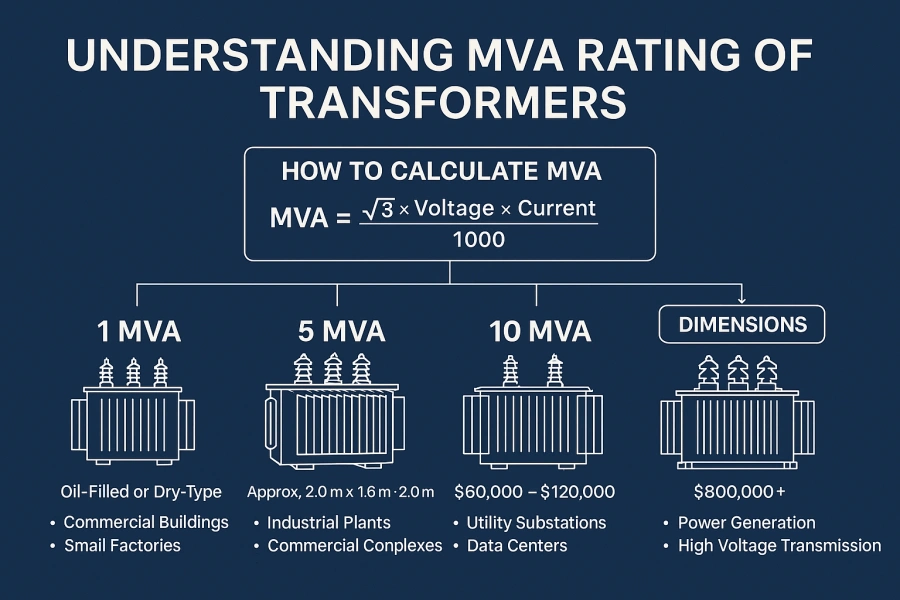Co je to jmenovitý výkon MVA u transformátorů?
MVA nebo Mega voltampéry, je jednotkou zdánlivý výkon se používá k určení kapacity transformátoru. Na rozdíl od kVA (kilo Volt-Amps), který se používá pro menší jednotky, se MVA běžně používá pro střední a velké výkonové transformátory.
Jmenovitý výkon MVA transformátoru udává maximální zatížení, které může transformátor za standardních provozních podmínek zvládnout, aniž by došlo k jeho přehřátí nebo poškození.
Jak vypočítat jmenovitý výkon MVA transformátoru
Vzorec pro výpočet jmenovitého výkonu MVA je následující:
MVA = (√3 × napětí vedení (kV) × proud vedení (A)) / 1000
Pro jednofázové transformátory platí vzorec:
MVA = (napětí (kV) × proud (A)) / 1000
Tento výpočet pomáhá zajistit správné dimenzování transformátoru pro průmyslové, komerční nebo komunální aplikace.
Co ovlivňuje velikost a jmenovitý výkon transformátoru?
Na stránkách fyzická velikost a MVA (Mega Volt-Ampere) jmenovitá hodnota transformátoru jsou určeny kombinací těchto parametrů elektrické, tepelné, mechanické a environmentální faktory. Pochopení těchto parametrů je zásadní pro správný výběr transformátoru, jeho výkon, životnost a bezpečnost v obytných, komerčních nebo průmyslových aplikacích.
✅ Klíčové faktory ovlivňující velikost a jmenovitý výkon transformátoru:
🔹 1. Úrovně napětí (primární a sekundární)
Vstupní (primární) a výstupní (sekundární) napětí určuje počet závitů vinutí a požadavky na izolaci.
Vyšší napětí vyžadují větší izolaci a větší volný prostor.
Běžné napěťové úrovně: 11kV, 33kV, 66kV, 110kV, 220kV a až 500kV.
🔹 2. Aktuální kapacita
Velikost proudu, který musí transformátor zvládnout, určuje. plocha průřezu vodičů.
Větší proud = silnější vinutí = větší velikost
Ovlivňuje také nárůst teploty a ztráty mědi
🔹 3. Jmenovitý výkon (zdánlivý výkon)
Celková kapacita transformátoru měřená v jednotkách. MVAovlivňuje velikost jádra, objem vodiče a potřebu chlazení.
1 MVA = 1 000 kVA
Vyšší MVA = větší plocha transformátoru a velikost nádrže
Přečtěte si více:Co je transformátor Kva
🔹 4. Frekvence systému (50 Hz nebo 60 Hz)
Frekvence napájecího systému ovlivňuje velikost magnetického jádra.
60Hz systémy (Severní Amerika) mohou používat o něco menší jádra než 50Hz systémy (Evropa, Asie).
Ovlivňuje hustotu magnetického toku a ztráty v železe
🔹 5. Okolní teplota
Teplota prostředí přímo ovlivňuje potřebu chlazení a stárnutí izolace.
Transformátory v horké podnebí (např. Mexiko, Brazílie) vyžadují zvýšenou ventilaci nebo snížení výkonu.
Instalace v chladné nebo vysokohorské oblasti vyžaduje ochranu proti zamrznutí a zohlednění studeného startu.
🔹 6. Způsob chlazení
Zvolená technika chlazení určuje velikost a složitost chladičů, ventilátorů a olejových čerpadel.
ONAN (Oil Natural Air Natural) - pasivní chlazení, používá se pro ≤10 MVA
ONAF (Olejový Natural Air Forced) - přidává ventilátory pro lepší rozptyl tepla
OFAF (olejové jednotky s nuceným oběhem vzduchu) - aktivní systém pro jednotky s vysokým výkonem, např. 50-500 MVA.
🔹 7. Požadavky na impedanci a účinnost
Transformátory s nízká impedance umožňují lepší regulaci napětí, ale vyžadují silnější vinutí.
Vysoká účinnost (98-99%) vyžaduje vysoce kvalitní materiály jádra a přesnost konstrukce.
Vliv na náklady, objem a výběr materiálu
🔹 8. Prostředí instalace
Místo instalace transformátoru významně ovlivňuje jeho velikost a konstrukci:
Vnitřní jednotky vyžadují kompaktní půdorys a suchou konstrukci.
Venkovní jednotky potřebují kryty odolné proti povětrnostním vlivům, ochranu proti korozi (nátěr pro námořní použití v pobřežních oblastech).
Pouštní nebo pobřežní oblasti (např. Peru, Chile, Guyana) vyžadují ochranu proti prachu, písku nebo solné mlze.
🛠 Kompromisy při navrhování
Konstruktéři musí najít rovnováhu mezi kompaktní konstrukcí, tepelným výkonem, náklady na materiál, mechanickou pevností a udržovatelností. To je důvod, proč vlastní dimenzování transformátorů je často nezbytná pro velké průmyslové a komunální projekty.
2. Vysvětlení velikosti transformátoru
Velikost transformátoru se týká fyzických rozměrů a celkové hmotnosti jednotky, které jsou přímo úměrné jejímu jmenovitému výkonu MVA. S rostoucím požadovaným výkonem musí transformátor obsahovat větší vnitřní součásti, vyšší úroveň izolace a dokonalejší chladicí systémy, což vše přispívá k nárůstu fyzických rozměrů a hmotnosti.
🔧 Co určuje velikost transformátoru?
Několik vnitřních konstrukčních faktorů se stupňuje s jmenovitým výkonem MVA:
Velikost jádra: Pro zabránění nasycení při vysokém výkonu je zapotřebí větší magnetické jádro.
Rozměry vinutí: Vyšší proud vyžaduje silnější vodiče a více mědi nebo hliníku.
Chladicí systém: Větší jednotky MVA produkují více tepla, což vyžaduje větší radiátory, ventilátory nebo systémy cirkulace oleje.
Objem izolace: Aby bylo možné zvládnout vyšší napětí a zabránit poruchám, je zapotřebí více prostoru a materiálu.
Konstrukční prvky: Nádrže, základní rámy a pouzdra jsou těžší a robustnější.
📦 Přibližné velikosti podle výkonu MVA
| Hodnocení MVA | Odhadovaná hmotnost | Typické rozměry (d x š x v) | Typ chlazení |
|---|---|---|---|
| 1 MVA | ~2 tuny (1 800-2 200 kg) | ~1,5 m × 1,1 m × 1,5 m | ONAN |
| 5 MVA | ~6-8 tun | ~2,5 m × 2 m × 2,2 m | ONAN / ONAF |
| 10 MVA | ~12-15 tun | ~3,5 m × 2,5 m × 2,5 m | ONAF |
| 100 MVA | 90-120+ tun | ~6,5 m × 4 m × 4,5 m | OFAF / Vodní chlazení |
🛠 Poznámka: Skutečné rozměry se liší v závislosti na napěťové třídě (např. 11kV, 33kV, 132kV), konstrukci chlazení a konkrétním použití.
🌍 Příklady z reálného světa
A Transformátor 1 MVA se běžně používá v malých průmyslových nebo domácích napájecích systémech. Je kompaktní a typicky suchý nebo chlazený ONAN.
A Transformátor 5 MVA se často vyskytuje ve středně velkých komerčních zařízeních, průmyslových závodech nebo rozvodných systémech.
A Transformátor 10 MVA podporuje velké továrny nebo zátěže na úrovni rozvoden, které vyžadují více aktivního chlazení.
A Transformátor 100 MVA se používá ve vysokonapěťových rozvodnách a přenosových soustavách. Jedná se o masivní jednotku, která vyžaduje náročnou přepravu a instalaci na konkrétním místě.
Dozvědět se více:220 kv 230kv vysokonapěťový speciální olejový transformátor
🌍 Spolupracujte s globálním lídrem v oblasti transformátorů
Ať už potřebujete transformátor o výkonu 1 MVA, 10 MVA nebo 100 MVA, Transformátor EVERNEW je důvěryhodným výrobcem a dodavatelem, který nabízí:
Řešení OEM a ODM
Globální dodávky a podpora
Certifikace: IEC, ANSI, UL, ISO
Aplikace: Komunální služby, průmysl, obnovitelná energie
Obsluhované trhy: USA, Kanada, Mexiko, Brazílie, Argentina, Guyana, Chile, Bolívie, Jamajka, Španělsko a další.
🔍 Dimenzování transformátorů a jmenovitý výkon - nejčastější dotazy
❓Jaký je vzorec pro výpočet MVA pro třífázový transformátor?
Odpověď:
MVA = (√3 × napětí vedení (kV) × proud vedení (A)) / 1000
Tento vzorec se běžně používá pro dimenzování výkonových transformátorů v průmyslových a komunálních aplikacích.
❓Jak vypočítám MVA pro jednofázový transformátor?
Odpověď:
MVA = (napětí vedení (kV) × proud vedení (A)) / 1000
To platí pro transformátory pro obytné a lehké komerční prostory.
❓Jak převedu kVA na MVA?
Odpověď:
MVA = kVA / 1000
Například 5000 kVA = 5 MVA.
❓Jak převedu MVA na kVA?
Odpověď:
kVA = MVA × 1000
Například 10 MVA = 10 000 kVA.
❓Jak vypočítám napětí, když znám kVA a proud?
Odpověď:
Napětí (V) = (kVA × 1000) / proud (A)
To je užitečné při odhadu potřeby napětí při výběru transformátoru.
❓Jak vypočítám kVA pro třífázový elektrický systém?
Odpověď:
kVA = (√3 × napětí (V) × proud (A)) / 1000
Jedná se o standardní vzorec pro většinu třífázových transformátorů.
❓Jak mohu určit sekundární napětí pomocí poměru otáček?
Odpověď:
V₂ = (T₂ × V₁) / T₁
Kde:
V₁ = primární napětí
T₁ = primární otáčky
T₂ = sekundární otáčky
V₂ = sekundární napětí
❓Jak zjistím primární napětí, když znám proudový poměr?
Odpověď:
V₁ = (V₂ × I₂) / I₁
Kde:
I₁ = primární proud
I₂ = sekundární proud
V₂ = sekundární napětí
V₁ = primární napětí

